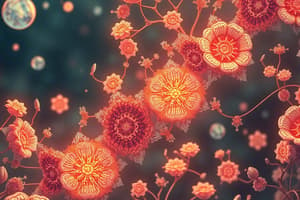Podcast
Questions and Answers
Which of the following bacteria are resistant to ciprofloxacin?
Which of the following bacteria are resistant to ciprofloxacin?
- E. coli, Klebsiella, and Salmonella
- Bacteroides fragilis, Clostridium difficile, and most anaerobes (correct)
- Staphylococcus aureus, Pseudomonas aeruginosa, and Mycobacterium tuberculosis
- Vibrio cholerae and Campylobacter jejuni
Which of the following routes of administration is NOT mentioned for ciprofloxacin?
Which of the following routes of administration is NOT mentioned for ciprofloxacin?
- Topical
- Intramuscular (correct)
- Oral
- Intravenous
Which of the following adverse effects of ciprofloxacin is NOT mentioned in the text?
Which of the following adverse effects of ciprofloxacin is NOT mentioned in the text?
- Headache, dizziness, insomnia, and confusion
- Muscle weakness and fatigue (correct)
- Nausea, vomiting, and abdominal discomfort
- Skin rashes, urticaria, and eosinophilia
Which newer fluoroquinolone has greater activity against streptococci and some activity against anaerobes?
Which newer fluoroquinolone has greater activity against streptococci and some activity against anaerobes?
Which of the following is NOT mentioned as a bacterium susceptible to ciprofloxacin?
Which of the following is NOT mentioned as a bacterium susceptible to ciprofloxacin?
Which of the following drug interactions with ciprofloxacin is NOT mentioned in the text?
Which of the following drug interactions with ciprofloxacin is NOT mentioned in the text?
What is the mechanism of action of nalidixic acid?
What is the mechanism of action of nalidixic acid?
Which bacteria is nalidixic acid NOT effective against?
Which bacteria is nalidixic acid NOT effective against?
What is the main adverse effect associated with fluoroquinolones?
What is the main adverse effect associated with fluoroquinolones?
What is the mechanism of action of fluoroquinolones?
What is the mechanism of action of fluoroquinolones?
Which of the following is a second-generation fluoroquinolone?
Which of the following is a second-generation fluoroquinolone?
What is the antibacterial spectrum of ciprofloxacin?
What is the antibacterial spectrum of ciprofloxacin?
Flashcards
What do quinolones and fluoroquinolones do?
What do quinolones and fluoroquinolones do?
A group of antibiotics that target and inhibit bacterial DNA synthesis, leading to bacterial cell death.
What is Nalidixic acid?
What is Nalidixic acid?
A first-generation quinolone that inhibits DNA gyrase, an enzyme crucial for bacterial DNA replication, and is specifically effective against certain gram-negative bacteria.
What are fluoroquinolones?
What are fluoroquinolones?
A class of antibiotics like Ciprofloxacin targeting both DNA gyrase and topoisomerase IV, inhibiting bacterial DNA replication and killing bacteria (bactericidal).
What is a key characteristic of Ciprofloxacin?
What is a key characteristic of Ciprofloxacin?
Signup and view all the flashcards
How does Ciprofloxacin travel through the body?
How does Ciprofloxacin travel through the body?
Signup and view all the flashcards
What are the main side-effects of fluoroquinolones?
What are the main side-effects of fluoroquinolones?
Signup and view all the flashcards
What are important contraindications and precautions for fluoroquinolones?
What are important contraindications and precautions for fluoroquinolones?
Signup and view all the flashcards
How can fluoroquinolones affect other drugs?
How can fluoroquinolones affect other drugs?
Signup and view all the flashcards
What is nalidixic acid used for?
What is nalidixic acid used for?
Signup and view all the flashcards
What else is nalidixic acid effective against?
What else is nalidixic acid effective against?
Signup and view all the flashcards
What is a serious potential side effect of fluoroquinolones?
What is a serious potential side effect of fluoroquinolones?
Signup and view all the flashcards
What is a specific concern with Moxifloxacin?
What is a specific concern with Moxifloxacin?
Signup and view all the flashcards
Study Notes
Quinolones and Fluoroquinolones
- The first quinolone, nalidixic acid, is a urinary antiseptic effective against gram-negative bacteria including E. coli, Proteus, Klebsiella, Enterobacter, Salmonella, and Shigella, but not Pseudomonas.
- Nalidixic acid inhibits DNA gyrase enzyme and interferes with the replication of bacterial DNA.
- It is useful in the treatment of uncomplicated UTI due to gram-negative bacteria and diarrhea due to Shigella or Salmonella.
Mechanism of Action
- Fluoroquinolones (FQs) inhibit bacterial DNA synthesis (bactericidal) by inhibiting DNA gyrase in gram-negative bacteria and topoisomerase IV in gram-positive bacteria.
Antibacterial Spectrum
- Ciprofloxacin is the prototype drug and is highly effective against aerobic gram-negative organisms:
- E. coli
- Coli
- Enterobacter
- Proteus
- Klebsiella
- Salmonella
- Shigella
- H. ducreyi
- H. influenzae
- N. gonorrhoeae
- N. meningitidis
- V. cholerae
- Campylobacter jejuni
- Ciprofloxacin also has activity against S. aureus, Pseudomonas aeruginosa, and M. tuberculosis.
Pharmacokinetics
- Ciprofloxacin is administered by oral, i.v., or topical routes.
- It is well absorbed from the gut, but food delays its absorption.
- It is widely distributed in the body and reaches high concentration in kidney, lung, prostatic tissue, bile, macrophages, etc.
- It is excreted mainly in urine.
Adverse Effects
- Common adverse effects are related to the Gl tract (nausea, vomiting, abdominal discomfort), CNS (headache, dizziness, insomnia, confusion, hallucinations, convulsions), and skin (rashes, urticaria, itching, eosinophilia, photosensitivity).
- Tenosynovitis and tendon rupture can occur, especially in athletes.
- Moxifloxacin can cause prolongation of QT interval.
Contraindications and Precautions
- FQs are contraindicated in pregnancy.
- FQs should be avoided in young children due to the risk of cartilage damage.
Drug Interactions
- Ciprofloxacin increases the plasma concentration of theophylline, warfarin, etc., by inhibiting their metabolism.
- Nonsteroidal anti-inflammatory drugs (NSAIDs) may potentiate CNS side effects of FQs (confusion, irritability, and rarely convulsions).
- Absorption of FQs is reduced by antacids, ferrous salts, and sucralfate.
Studying That Suits You
Use AI to generate personalized quizzes and flashcards to suit your learning preferences.




